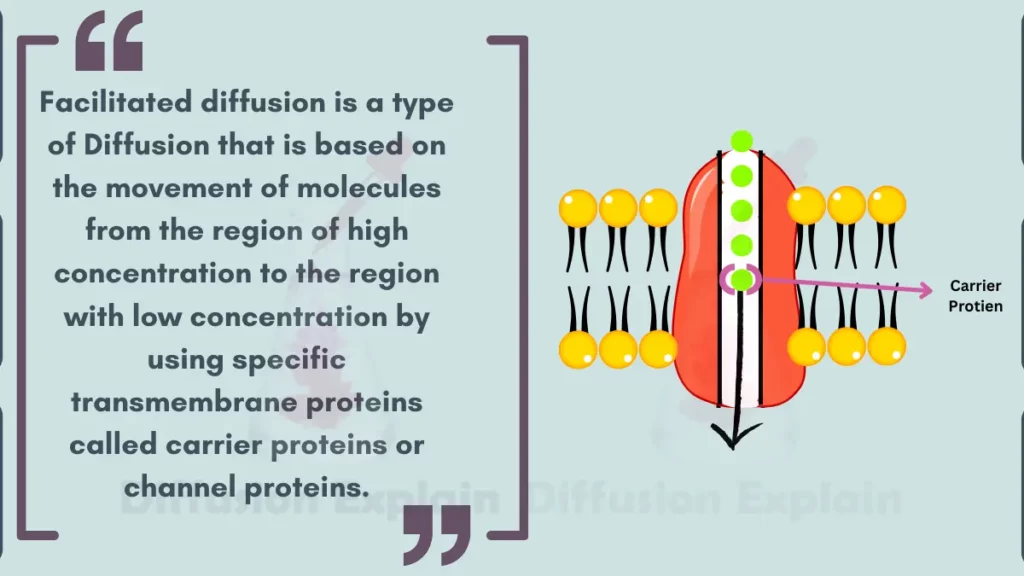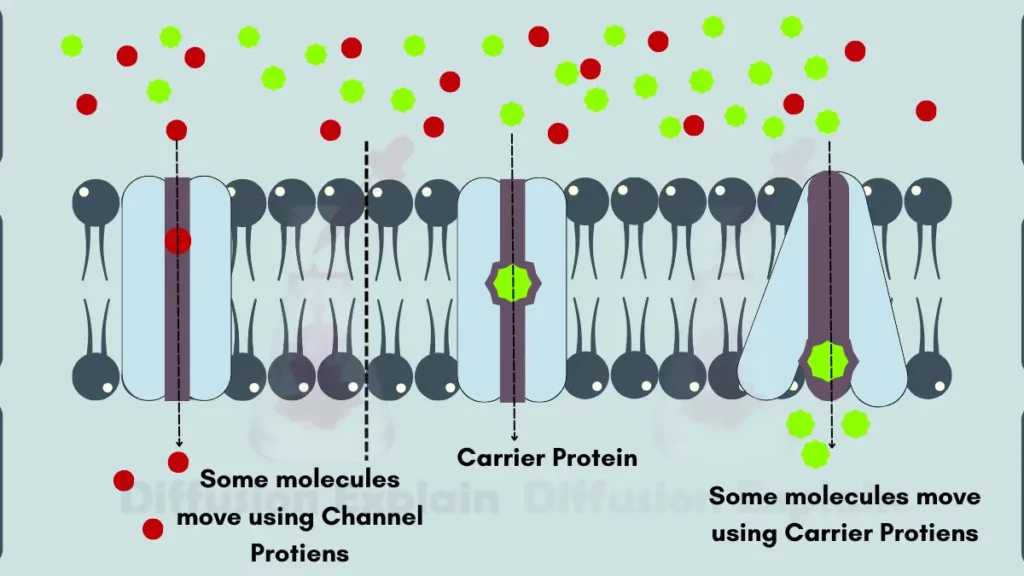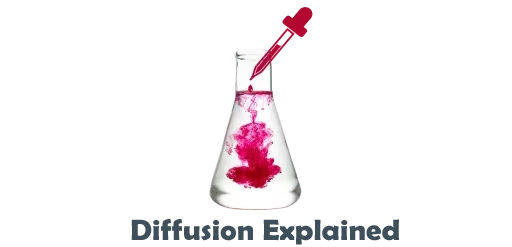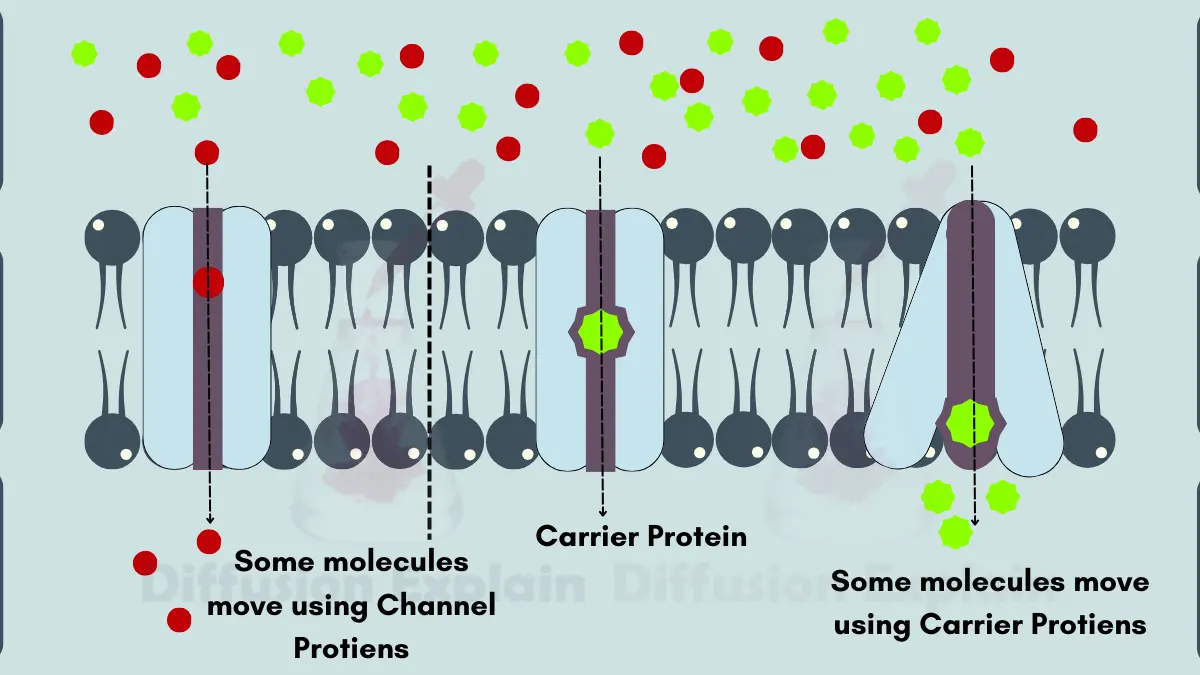What is Facilitated Diffusion?
Facilitated diffusion is a type of Diffusion that is based on the movement of molecules from the region of high concentration to the region with low concentration by using specific carrier proteins or channel proteins.

Just like simple diffusion, It also happens because of a concentration gradient. It requires no additional energy input like active transport. In facilitated diffusion, specific transmembrane proteins called carrier proteins or channel proteins facilitate the transport of molecules across the cell membrane.
Unlike active transport, facilitated diffusion does not transport molecules against their concentration gradient and therefore it does not require energy from ATP hydrolysis.
Charectristics of Facilitated Diffusion
Here are the main Charectristics of Facilitated Diffusion:
- Facilitated diffusion requires no external energy, utilizing the inherent kinetic energy of molecules.
- Substances move from higher to lower concentration areas, driven by a concentration gradient, reaching equilibrium when evenly distributed.
- Specific transport proteins embedded in the membrane guide and facilitate the movement of selected molecules.
- Transport proteins are specific to certain molecules or ions, ensuring controlled movement across the membrane.
- Facilitated diffusion is passive, not directly requiring ATP energy like active transport.
- Facilitated diffusion is crucial for transporting large molecules or charged ions unable to pass through the membrane independently.
- Facilitated diffusion plays important role in regulating cellular activities by controlling specific molecule movement.
- The rate of facilitated diffusion depends on factors like the number of available transport proteins and the concentration gradient.
Types of Facilitated Diffusion
Facilitated diffusion involves the passive movement of substances across a plasma membrane with the help of transport proteins. There are two main types of facilitated diffusion:

Channel-Facilitated Diffusion
Channel proteins create pores in the cell membrane, that allows charged molecules to pass through selectively. For examples, movement of aquaporins that facilitate the transport of water and ion channels that regulate the selective transport of ions and solutes across the plasma membrane. [source]
Channel proteins are structures that span the cell membrane. It creates hydrophilic Channels for specific molecules to pass through by diffusion. They help polar and charged compounds avoid the hydrophobic interior of the membrane which would slow or block entry.
Aquaporins are a type of channel that let water molecules cross rapidly. They’re crucial in some plant/animal cells to reduce water loss.
Some channels are gated, meaning they can open or close in response to signals. Nerve/muscle cells have gated ion channels for sodium, potassium and calcium. The opening and closing of these channels is vital for nerve signaling and muscle contraction. [source]
Carrier-Facilitated Diffusion
In this type, carrier proteins bind to specific molecules, undergo a conformational change, and transport the molecules across the membrane. An example is the glucose transporter that facilitates the movement of glucose across the plasma membrane. [source]
Carrier proteins also facilitate transport across membranes. Unlike channels, they change their shape to move target molecules from one side to the other.
Like channels, carrier proteins are selective for certain substances. They may change shape when binding targets, moving them across the membrane down their concentration gradient.
Channels typically facilitate much faster diffusion than carriers. Channels form protein tunnels that don’t require shape changes while carrier proteins must change conformation for each molecule they transport. [source]
Process of Facilitated Diffusion Mechanism
Here are the main steps involved in transport of moelcules through facilitated difusion:

- Binding – First step of facilitated diffusion process is binding. A specific transport protein in the cell membrane encounters a molecule needing transport on one side of the membrane. This molecule binds to a specific binding site on the protein. This binding occurs at a specific site on the protein with a high affinity for the molecule.
- Conformational change – After binding, the transport protein undergoes a shape change that is known as conformational change. This change creates a tunnel or passageway within the protein.
- Movement across membrane – The bound molecule is then transported through the tunnel formed by the changed shape of the protein, allowing it to pass across the cell membrane.
- This can happen in two ways:
- Uniport – A single molecule is transported across the membrane in one direction (down its concentration gradient).
- Facilitated diffusion – Multiple molecules can be transported across the membrane, either in the same direction (symport) or in opposite directions (antiport).
- Release – Once the molecule reaches the other side of the membrane, it is released from the transport protein.
- Reset – The transport protein returns to its original shape, ready to bind another molecule and repeat the process.
Common Examples of Facilitated Diffusion
Here are some common examples of facilitated diffusion:
- Glucose transport – Glucose, a key energy source for cells, is too large and polar to pass directly through the cell membrane. Glucose transporters in the membrane act as “facilitators” by binding to glucose molecules and transporting them across. [source]
- Amino acid transport – Similar to glucose, amino acids also require carrier proteins for facilitated diffusion across the membrane due to their size and chemical properties. [source]
- Gas transport – Oxygen and carbon dioxide, essential gases for cellular respiration, rely on facilitated diffusion through specialized channels in the cell membrane. These channels, like aquaporins for water and ion channels for specific ions, allow for specific and efficient transport. [source]
- Nutrient absorption in the gut – After digestion, smaller molecules like glucose and amino acids are absorbed from the small intestine into the bloodstream through facilitated diffusion with the help of specific transporters in the intestinal lining. [source]

